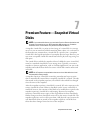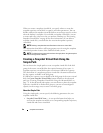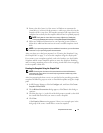
Snapshot Virtual Disks 69
•
Snapshot Repository Virtual Disk Name
— A user-specified name that
helps you associate the snapshot repository virtual disk to its corresponding
snapshot virtual disk and source virtual disk.
Using the simple path, the following defaults are used for the other
parameters of a snapshot virtual disk:
•
Capacity Allocation
— The snapshot repository virtual disk is created
using free capacity on the same disk group where the source virtual disk
resides.
•
Host-to-Virtual Disk Mapping
— The default setting is
Map now
.
•
Percent Full
— When the snapshot repository virtual disk reaches the
specified repository full percentage level, the event is logged in the Main
Event Log (MEL). The default snapshot repository full percentage level is
50 percent of the source virtual disk.
•
Snapshot Repository Virtual Disk Full Conditions
— When the snapshot
repository virtual disk becomes full, you are given a choice of failing write
activity to the source virtual disk or failing the snapshot virtual disk.
Preparing Host Servers to Create the Snapshot Using the Simple Path
NOTICE: Before using the Snapshot Virtual Disks Premium Feature in a Microsoft
®
Windows
®
clustered configuration, you must first map the snapshot virtual disk to
the cluster node that owns the source virtual disk. This ensures that the cluster
nodes correctly recognize the snapshot virtual disk.
Mapping the snapshot virtual disk to the node that does not own the source virtual
disk before the Snapshot enabling process is completed can result in the operating
system mis-identifying the snapshot virtual disk. This, in turn, can result in data loss
on the source virtual disk or an inaccessible snapshot.
For details on mapping the snapshot virtual disk to the secondary node, refer to the
Dell PowerEdge™ Cluster SE600W Systems Installation and Troubleshooting Guide
on support.dell.com
NOTE: You can create concurrent snapshots of a source virtual disk on both the
source disk group and on another disk group.


















